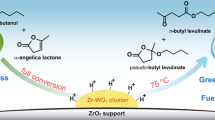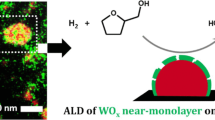Abstract
Cyclohexanone is a crucial intermediate for producing nylon and other industrial products. However, the direct hydrogenation of phenol for synthesizing cyclohexanone easily generates cyclohexanol and thus reduce the yield. In this work, the Pd/WO3 catalysts with different Pd contents (Pd/WO3-1–0.21 wt%, Pd/WO3-2–0.69 wt%, Pd/WO3-3–2.20 wt%) are prepared via using sodium borohydride liquid phase reduction, which have good catalytic performance for phenol selective hydrogenation. The Pd/WO3-2 catalyst can achieve 92.9% conversion, 84.4% selectivity and high TOF (turnover frequency) of 349.1 h−1 under the reaction conditions (120 °C, 2 h, 3.0 MPa H2). The nanostructures of the catalysts are extensively characterized by XRD, XPS, SEM, TEM, HRTEM, STEM and STEM-EDS elemental mapping and line-scanning. It is found that the Pd/WO3-2 catalyst has a high Pd dispersion and quite tiny Pd clusters. Alternatively, the stability experiment of Pd/WO3-2 indicates that the conversion decreases from 92.9% to 87.5% and the selectivity to cyclohexanone does not change significantly (84%) after it is recycled for five times.
Graphic Abstract







Similar content being viewed by others
References
Xu J, Zhu L, Zhang H et al (2023) SiO2-supported Pd nanoparticles for highly efficient, selective and stable phenol hydrogenation to cyclohexanone. Mol Catal 538:112975
Chen H, He Y, Pfefferle LD et al (2018) Phenol catalytic hydrogenation over palladium nanoparticles supported on metal–organic frameworks in the aqueous phase. ChemCatChem 10:2558–2570
Valentini F, Santillo N, Petrucci C et al (2018) Continuous-flow palladium-catalyzed synthesis of cyclohexanones from phenols using sodium formate as a safe hydrogen source. ChemCatChem 10:1277–1281
Zhang C, Qu Z, Jiang H et al (2022) Nb2O5 promoted Pd/AC catalyst for selective phenol hydrogenation to cyclohexanone. Chin J Chem Eng 44:87–93
Xu X, Li H, Wang Y (2014) Selective hydrogenation of phenol to cyclohexanone in water over Pd@N-doped carbon derived from ionic-liquid precursors. ChemCatChem 6:3328–3332
Wang W, Yang G, Wang Q et al (2022) Modifying carbon nanotubes supported palladium nanoparticles via regulating the electronic metal–carbon interaction for phenol hydrogenation. Chem Eng J 436:131758
Chatterjee M, Kawanami H, Sato M et al (2009) Hydrogenation of phenol in supercritical carbon dioxide catalyzed by palladium supported on Al-MCM-41: a facile route for one-pot cyclohexanone formation. Adv Synth Catal 351:1912–1924
Tétényi P, Paál Z (2002) Comment on “Dehydrogenation of cyclohexanol on copper containing catalysts. I. The influence of the oxidation state of copper on the activity of copper sites” by V. Z. Fridman and A. A. Davydov. J Catal 208:494–496
Zhu J, Tao G, Liu H et al (2014) Aqueous-phase selective hydrogenation of phenol to cyclohexanone over soluble Pd nanoparticles. Green Chem 16:2664–2669
Jiang H, Qu Z, Li Y et al (2016) One-step semi-continuous cyclohexanone production via hydrogenation of phenol in a submerged ceramic membrane reactor. Chem Eng J 284:724–732
Yin D, Ji R, Yu S et al (2022) Metal-acid interface encapsulated in hybrid mesoporous silica for selective hydrogenation of phenol to cyclohexanone. Mol Catal 530:112526
Xu G, Guo J, Zhang Y et al (2015) Selective hydrogenation of phenol to cyclohexanone over Pd-HAP catalyst in aqueous media. ChemCatChem 7:2485–2492
Wu Q, Wang L, Zhao B et al (2022) Highly selective hydrogenation of phenol to cyclohexanone over a Pd-loaded N-doped carbon catalyst derived from chitosan. J Colloid Interf Sci 605:82–90
Yang C, Li K, Wang J et al (2021) Selective hydrogenation of phenol to cyclohexanone over Pd nanoparticles encaged hollow mesoporous silica catalytic nanoreactors. Appl Catal A Gen 610:117961
Singh N, Lee MS, Akhade SA et al (2019) Impact of pH on aqueous-phase phenol hydrogenation catalyzed by carbon-supported Pt and Rh. ACS Catal 9:1120–1128
Wang M, Yang W (2022) Pt nanoparticles confined in TiO2 nanotubes with enhanced catalytic performance for phenol hydrogenation by atomic layer deposition. Catal Lett 152:1020–1028
Yang X, Yu X, Long L et al (2014) Pt nanoparticles entrapped in titanate nanotubes (TNT) for phenol hydrogenation: the confinement effect of TNT. Chem Commun 50:2794–2796
Zhang H, Han A, Okumura K et al (2018) Selective hydrogenation of phenol to cyclohexanone by SiO2-supported rhodium nanoparticles under mild conditions. J Catal 364:354–365
Ertas IE, Gulcan M, Bulut A et al (2015) Rhodium nanoparticles stabilized by sulfonic acid functionalized metal–organic framework for the selective hydrogenation of phenol to cyclohexanone. J Mol Catal A Chem 410:209–220
Zhang H, Zhong L, Samsudin IB et al (2022) Mg-stabilized subnanometer Rh particles in zeolite Beta as highly efficient catalysts for selective hydrogenation. J Catal 405:489–498
Wang S, Wang J, Li X et al (2022) Superhydrophobic Ru catalyst for highly efficient hydrogenation of phenol under mild aqueous conditions. Catalysts 12:995–1007
Vono LL, Broicher C, Philippot K et al (2020) Tuning the selectivity of phenol hydrogenation using Pd, Rh and Ru nanoparticles supported on ceria- and titania-modified silicas. Catal Today 381:126–132
Zhang Z, Ding L, Gu J et al (2017) 3D charged grid induces a high performance catalyst: ruthenium clusters enclosed in X-zeolite for hydrogenation of phenol to cyclohexanone. Catal Sci Technol 7:5953–5963
Dong J, Wen X, Zhu T et al (2020) Hierarchically nanostructured bimetallic NiCo/MgxNiyO catalyst with enhanced activity for phenol hydrogenation. Mol Catal 485:110846
Shi Y, Chen S, He L et al (2019) Selective conversion of phenol in a subcritical water medium using γ-Al2O3 supported Ni–Co bimetallic catalyst. Catalysts 9:212–224
Zhang L, Fang Y, Du Z et al (2021) Highly selective hydrogenation of phenol catalyzed by porous BN supported Ni–Pd catalysts. ChemistrySelect 6:5975–5982
Chen C, Liu P, Zhou M et al (2020) Selective hydrogenation of phenol to cyclohexanol over Ni/CNT in the absence of external hydrogen. Energies 13:846–857
Raut AN, Nandanwar SU, Suryawanshi YR et al (2016) Liquid phase selective hydrogenation of phenol to cyclohexanone over Ru/Al2O3 nanocatalyst under mild conditions. Kinet Catal 57:39–46
Akbayrak S (2018) Decomposition of formic acid using tungsten(VI) oxide supported AgPd nanoparticles. J Colloid Interf Sci 538:682–688
Akbayrak S, Hacettepe, (2018) Tungsten(VI) oxide supported rhodium(0) nanoparticles used as catalyst in hydrogenation of benzene at room temperature. J Biol Chem 4:465–472
Rutkowska IA, Marks D, Perruchot C et al (2013) Admixing palladium nanoparticles with tungsten oxide nanorods toward more efficient electrocatalytic oxidation of formic acid. Colloids Surf A Physicochem Eng Asp 439:200–206
Wei S, Zhu X, Zhang P et al (2021) Aerobic oxidation of methane to formaldehyde mediated by crystal-O over gold modified tungsten trioxide via photocatalysis. Appl Catal B Environ 283:119661
Türkaslan BE, Çelik AK, Dalbeyler A et al (2022) The effect of different morphologies of WO3/GO nanocomposite on photocatalytic performance. Materials 15:8019
Sirotkin NA, Khlyustova AV, Titov VA et al (2020) Synthesis and photocatalytic activity of WO3 nanoparticles prepared by underwater impulse discharge. Plasma Chem Plasma P 40: 571–587.
Abbaspoor M, Aliannezhadi M, Tehrani FS (2022) High-performance photocatalytic WO3 nanoparticles for treatment of acidic wastewater. J Sol-Gel Sci Technol 105:565–576
Miu EV, McKone JR, Mpourmpakis G (2022) The sensitivity of metal oxide electrocatalysis to bulk hydrogen intercalation: Hydrogen evolution on tungsten oxide. J Am Chem Soc 144:6420–6433
Jiang H, Wang Y, Hu J et al (2023) Phase regulation of WO3 for highly selective oxygen reduction to hydrogen peroxide. Chem Eng J 452:139449
Lu K, Wang Z, Wu Y et al (2023) Synergistic effect of F doping and WO3 loading on electrocatalytic oxygen evolution. Chem Eng J 451:138590
Wang C, Zhang S, Qiu L et al (2020) Ru-decorated WO3 nanosheets for efficient xylene gas sensing application. J Alloy Compd 826:154196
Militello MC, Simko SJ (1994) Elemental palladium by XPS. Surf Sci Spectra 3:387–394
Yuan S, Duan Y, Yu C et al (2023) Construction of defects-rich TiO2-supported Pd catalyst for phenol hydrogenation with ball-milling process. Mol Catal 535:112830
Li Y, Zhang X, Peng Z et al (2020) Highly efficient hydrolysis of ammonia borane using ultrafine bimetallic RuPd nanoalloys encapsulated in porous g-C3N4. Fuel 277:118243
Si J, Ouyang W, Zhang Y et al (2017) Novel nano-semiconductor film layer supported nano-Pd complex nanostructured catalyst Pd/Ⓕ-MeOx/AC for high efficient selective hydrogenation of phenol to cyclohexanone. Sci Rep 7:1254
Zhang J, Liu Y, Jiang H et al (2019) Fabrication of Pd@N-doped porous carbon-TiO2 as a highly efficient catalyst for the selective hydrogenation of phenol to cyclohexanone in water. React Kinet Mech Catal 126:463–476
Acknowledgements
This work was supported by the National Natural Science Foundation of China (Grant Nos. 22162012 and 22202089), Youth Jinggang Scholars Program in Jiangxi Province (57), Thousand Talents Plan of Jiangxi Province (jxsq2019201083), Natural Science Foundation of Jiangxi Province for Distinguished Young Scholars (Grant No. 20224ACB213005), Program of Qingjiang Excellent Young Talents, Jiangxi University of Science and Technology (JXUSTQJBJ2019002), Research Foundation of Education Bureau of Jiangxi Province of China (GJJ210833), and Jiangxi Provincial Key Laboratory of Functional Molecular Materials Chemistry (20212BCD42018).
Author information
Authors and Affiliations
Corresponding author
Ethics declarations
Conflict of interest
The authors declare that they have no conflict of interest.
Additional information
Publisher's Note
Springer Nature remains neutral with regard to jurisdictional claims in published maps and institutional affiliations.
Rights and permissions
Springer Nature or its licensor (e.g. a society or other partner) holds exclusive rights to this article under a publishing agreement with the author(s) or other rightsholder(s); author self-archiving of the accepted manuscript version of this article is solely governed by the terms of such publishing agreement and applicable law.
About this article
Cite this article
Li, K., Xu, J., Zhang, H. et al. Highly Selective Hydrogenation of Phenol to Cyclohexanone Using WO3 Supported Tiny Pd Clusters Catalysts. Catal Lett 153, 3044–3052 (2023). https://doi.org/10.1007/s10562-023-04431-x
Received:
Accepted:
Published:
Issue Date:
DOI: https://doi.org/10.1007/s10562-023-04431-x




